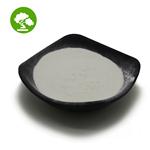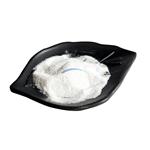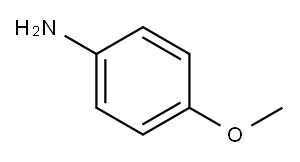p-Anisidine: properties, applications and safety
Dec 18,2023
General Description
p-Anisidine is an organic compound with a chemical formula of C7H9NO, primarily used as an intermediate in dye and pharmaceutical industries. It has a pale yellow crystalline appearance, with a melting point around 56 degrees Celsius. Its chemical properties are influenced by its aniline moiety and methoxy group. It's moderately soluble in water and more so in organic solvents. However, it poses health risks upon exposure, including headaches, dizziness, cyanosis, and formation of Heinz bodies in red blood cells. Chronic exposure can lead to bladder cancer and methemoglobinemia. Therefore, it's crucial to handle p-Anisidine with proper safety measures.

Figure 1. p-Anisidine
Properties
p-Anisidine is an organic compound with the chemical formula C7H9NO. It appears as a pale yellow crystalline solid at room temperature and has a melting point of about 56 degrees Celsius. This aromatic amine is characterized by an aniline moiety connected to a methoxy group at the para position, which significantly influences its chemical properties. p-Anisidine is moderately soluble in water and more so in organic solvents such as ethanol and ether. Its molecular weight is 123.15 g/mol, and it has a density of approximately 1.09 g/cm³. As an amine, it is a weak base and can form salts with acids. 1
Applications
p-Anisidine is an organic compound that finds extensive applications in both the dye and pharmaceutical industries due to its versatile chemical properties. In the realm of dye manufacturing, p-Anisidine acts as a crucial intermediate for the production of ice dyes, contributing to the creation of vibrant colorants such as Acid Red GP, Direct Blue VB, Acid Alizarin Violet N, and Disperse Blue 79. These dyes are essential for textile and other industrial applications where colorfastness and stability are required. In the pharmaceutical sector, p-Anisidine's derivatives play a significant role in formulating drugs with anti-inflammatory and antipyretic effects. Medications such as Phenazopyridine, used to alleviate urinary tract discomfort, and Bucillamine, a disease-modifying antirheumatic drug, are synthesized using p-Anisidine as an intermediate. Furthermore, p-Anisidine is also utilized in analytical chemistry as a complexometric indicator for iron(III) ions, aiding in the precise determination of iron content in various samples. Its utility extends into organic synthesis, where it serves as a building block for crafting complex organic structures, showcasing its importance in diverse chemical processes. 2,3
Safety
p-Anisidine is a chemical compound that poses various health risks upon exposure. It can enter the body through inhalation, skin absorption, ingestion, or direct contact with skin and eyes. Symptoms of exposure include headaches, dizziness, cyanosis (a bluish discoloration of the skin due to insufficient oxygen), and the formation of Heinz bodies in red blood cells, which are indicators of cell damage. The substance targets multiple organs, including the blood, kidneys, liver, cardiovascular system, and central nervous system. Chronic feeding studies in animals have linked p-Anisidine to bladder cancer, and methemoglobinemia, a condition where hemoglobin is modified to methemoglobin which cannot carry oxygen effectively, has been reported in exposed workers. The American Conference of Governmental Industrial Hygienists (ACGIH) notes that methemoglobin formation is not the principal cause of toxicity for p-Anisidine, suggesting other mechanisms may also contribute to its harmful effects. The International Agency for Research on Cancer (IARC) classifies p-Anisidine as Group 3, meaning it is not classifiable as to its carcinogenicity to humans, while o-Anisidine is classified as Group 2B, indicating it is possibly carcinogenic. In addition to its systemic toxicity, p-Anisidine is an irritant to the skin, eyes, and respiratory tract, and can induce methemoglobinemia. Due to its irritating properties, it can cause severe discomfort and damage to mucous membranes upon contact. It is crucial to handle p-Anisidine with appropriate safety measures to prevent exposure and protect human health. 4
Reference
1. p-Anisidine. National Center for Biotechnology Information (2023). PubChem Compound Summary for CID 7732.
2. ACGIH - Documentation of the TLVs and BEIs, 7th Ed. Cincinnati: ACGIH Worldwide, 2020.
3. PubChem Annotation Record for p-Anisidine. National Center for Biotechnology Information, 2023, Hazardous Substances Data Bank.
4. p-Anisidine. Haz-Map, Information on Hazardous Chemicals and Occupational Diseases, 758
- Related articles
- Related Qustion
- p-Anisidine: Natural Occurrence and Application in Chemical Detection Apr 30, 2024
p-Anisidine's natural occurrence in plants and presence in food and environmental matrices underscore its significance in chemical detection.
- Acute Toxicologic Evaluation at p-Anisidine Dec 1, 2023
p-Anisidine produced conjunctival injection, chemosis, and colorless diseharge. Miosis was observed from 15 min-2 hrs. Ocular effects disappeared in 1 eye at 72 hrs.
- What is p-anisidine? Oct 20, 2023
p-Anisidine is a yellow to brown crystalline (sand-like) solid with a fishy odor. It is used as an intermediate in making dyes.
Albendazole sulfoxide, the active metabolite of Albendazole, causes selective degeneration of cytoplasmic microtubules in intestinal and tegmental cells of intestinal helminths and larvae.....
Dec 15,2023API2,2,6,6-Tetramethylpiperidine is a colorless organic base used in deprotonation reactions, synthesized from tetraalkylpyridines, with its derivatives aiding in selective oxidation processes.....
Dec 18,2023APIp-Anisidine
104-94-9You may like
- p-Anisidine
-

- $0.00/ KG
- 2024-04-12
- CAS:104-94-9
- Min. Order: 1KG
- Purity: 99%
- Supply Ability: 200kg Per Drum
- p-Anisidine
-

- $30.00/ KG
- 2023-10-08
- CAS:104-94-9
- Min. Order: 1KG
- Purity: 99%
- Supply Ability: 20T
- p-Anisidine
-

- $0.00 / 1kg
- 2023-09-12
- CAS:104-94-9
- Min. Order: 1kg
- Purity: 99%
- Supply Ability: 20tons





